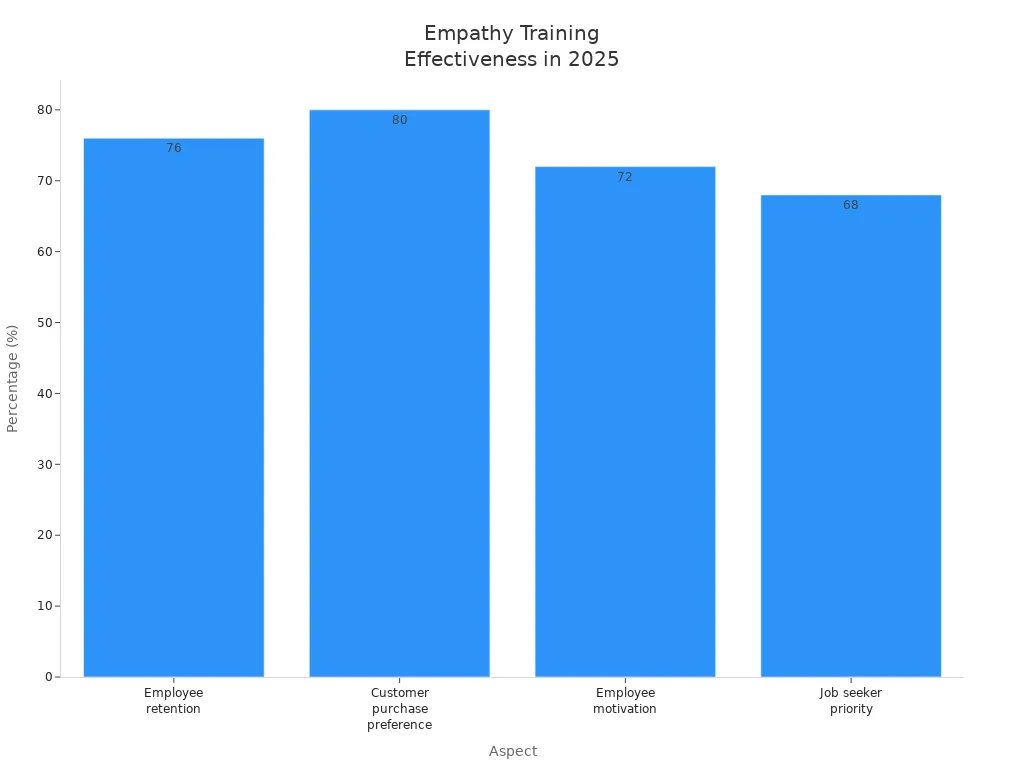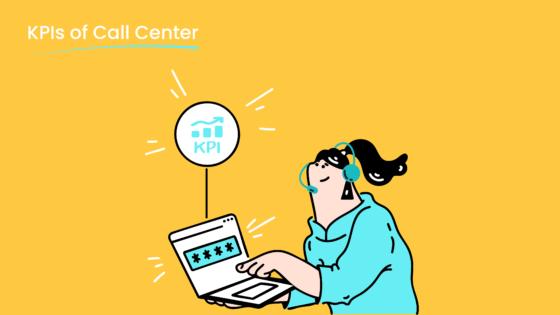Customer Service Empathy Training Strategies for Better Results

You want your customer service team to stand out in 2025. The most effective strategy is customer service empathy training. Empathy drives real results—76% of employees stay longer where leaders show empathy, and 80% of customers prefer brands that show understanding. Sobot and Sobot AI help you connect with customers by combining advanced technology with human-centered training. With Sobot call center solutions, you give your team tools to understand every customer’s needs and deliver fast, caring service.
| Aspect | Statistic / Fact | Source (2025) |
|---|---|---|
| Employee retention | 76% of employees more likely to stay where leaders show empathy | Gallup |
| Customer purchase preference | 80% of consumers prefer brands that show understanding and care | Forbes |
| Employee motivation | 72% of employees feel more motivated when leaders display empathy | LinkedIn Leadership Survey |
| Job seeker priority | 68% of job seekers prioritize empathy in company culture | LinkedIn Talent Trends |

Importance of Empathy

Empathy in Customer Service
You play a key role in shaping every customer interaction. Empathy in customer service means you listen, understand, and respond to customers with care. This skill helps you build trust and rapport, which leads to better relationships and loyalty. When you show empathy, you make customers feel valued and heard.
- Empathy helps you handle tough situations. You can calm upset customers and prevent problems from getting worse.
- Customers want to feel understood. When you use empathy, you address their needs with personalized solutions.
- Empathy in customer service also benefits you and your team. It boosts morale and makes your work more rewarding.
Research shows that empathy triggers positive feelings in customers. When you express empathy, customers feel less stress and more cooperation. This leads to better outcomes for everyone. Companies that focus on empathy in customer service see higher satisfaction scores and fewer complaints. Sobot’s unified workspace and AI-powered tools help you keep track of customer needs, so you can respond with empathy every time.
“Empathy is not just a soft skill. It is a business strategy that sets you apart in a crowded market.”
Impact on Customer Satisfaction
Empathy has a direct impact on customer satisfaction. When you show empathy, customers are more likely to trust your brand and return for future purchases. Studies reveal that 77% of business leaders agree that empathy leads to higher customer retention. In fact, 88% of customers say good service makes them more likely to buy again. PwC reports that 59% of customers will leave a brand after a bad experience, which shows the importance of empathy in every interaction.
A major bank saw its customer satisfaction scores rise from 72% to 88% after empathy-focused training. Customers responded with appreciation, and the company saw better payment behavior. Empathy-focused training programs in other industries, like healthcare, also lead to higher satisfaction and fewer complaints.
You can use empathy to:
- Build stronger connections with customers
- Improve conflict resolution
- Increase loyalty and positive word-of-mouth
Sobot’s omnichannel solutions make it easier for you to deliver empathetic service across all channels. With real-time analytics and unified customer data, you can personalize every interaction and boost customer satisfaction.
Customer Service Empathy Training
Empathy is the foundation of every successful customer service training program. When you focus on empathy and personalization, you help your team connect with customers on a deeper level. This approach leads to better outcomes for both your business and your customers. You can build these skills through targeted training that covers active listening, emotional intelligence, and reflective responses. These soft skills are essential for delivering empathetic customer support and creating positive experiences.
Active Listening Skills
Active listening is one of the most important customer service skills. You show customers that you care by giving them your full attention. This skill helps you understand their needs and emotions, which is the first step in empathy in customer support. When you listen actively, you avoid making assumptions and instead focus on what the customer is really saying.
Here are proven active listening techniques that improve empathy in customer service interactions:
- Ask follow-up questions to keep the conversation going and show genuine interest.
- Reflect back the customer's situation to demonstrate understanding.
- Show empathy and patience, especially when customers feel upset or frustrated.
- Avoid rushing customers. Give them time to share their concerns fully.
- Engage in authentic, personal conversations instead of sticking to scripts.
Tip: Use open-ended questions like, "Can you tell me more about your experience?" This encourages customers to share details and helps you personalize interactions.
You can also use body language, such as nodding or maintaining eye contact, to show engagement during in-person or video calls. In digital channels, quick responses and thoughtful emojis can help convey empathy and personalization. Sobot’s omnichannel solution supports these techniques by unifying all customer communication in one workspace, making it easier for you to track conversations and respond with empathy.
Active listening leads to several benefits:
- Customers feel heard and valued.
- You can provide personalized solutions that address real needs.
- It helps diffuse tension and resolve conflicts faster.
- Your brand reputation improves as customers share positive experiences.
When you practice active listening, you build trust and loyalty. This is why customer service empathy training always starts with listening skills.
Emotional Intelligence
Emotional intelligence (EI) is the ability to recognize, understand, and manage your own emotions and those of others. In customer service training, EI helps you respond to customers with empathy, even in stressful situations. High EI allows you to stay calm, communicate clearly, and resolve conflicts effectively.
Training in emotional intelligence brings many benefits to customer service teams:
- It improves empathy, self-regulation, and communication skills.
- Teams with high EI handle difficult conversations with confidence.
- Companies like Ritz-Carlton empower employees to use EI for better customer experiences.
- EI training includes role-playing, real call analysis, and continuous feedback.
A TalentSmart study found that 90% of top performers have high emotional intelligence. When you invest in EI training, you see higher customer satisfaction, increased loyalty, and reduced employee turnover. For example, a tech startup reduced turnover from 25% to 10% in one year after EI training. Retail chains have seen up to a 20% increase in sales and a 30% rise in customer service ratings after implementing EI programs.
Note: Emotional intelligence is not just about managing emotions. It also helps you build genuine connections and foster teamwork. This is why soft skills training is a key part of effective customer service training.
Sobot’s unified workspace and AI-powered analytics can support your team’s EI development. Real-time feedback and performance insights help agents reflect on their interactions and improve their emotional intelligence over time.
Reflective Responses
Reflective responses are a powerful tool in customer service empathy training. When you use reflective responses, you show customers that you truly understand their feelings and concerns. This goes beyond scripted empathy statements. You create a real connection by responding in a way that matches the customer’s emotions and needs.
Best practices for teaching reflective responses include:
- Give your full attention by eliminating distractions and focusing on the customer’s words and tone.
- Use body language, such as nodding or mirroring, to show engagement.
- Respond genuinely to demonstrate that the customer is heard and valued.
- Paraphrase what the customer says and ask clarifying questions to ensure understanding.
- Practice regularly and seek feedback to improve your skills.
Example: If a customer says, “I’m frustrated because my order is late,” you might reply, “I understand how frustrating it is to wait for something important. Let me check on your order right now.”
You can adapt reflective responses across different channels. On calls, use verbal affirmations and paraphrasing. In live chat, use quick, thoughtful replies and emojis. In emails, summarize the customer’s concerns and provide clear, personalized solutions.
Sobot’s Voice/Call Center and omnichannel solutions make it easy to track customer history and personalize every response. With features like real-time monitoring and unified customer data, you can deliver empathetic customer support at every touchpoint.
Reflective responses help you:
- Build trust and rapport with customers.
- Validate customer emotions and diffuse tension.
- Increase satisfaction and loyalty.
Remember: Empathy in customer support is not a one-time skill. It requires ongoing practice, feedback, and support. Sobot’s training program and analytics tools help you sustain these skills and create a culture of empathy.
Why Invest in Customer Service Empathy Training?
Customer service empathy training delivers proven benefits for your business:
- It enables you to provide personalized solutions by understanding customer emotions and needs.
- You help alleviate customer frustrations by validating feelings and diffusing tension.
- Your brand reputation improves as you foster positive customer perceptions.
- You see increased customer satisfaction, loyalty, and retention rates.
- Higher conversion rates and positive word-of-mouth referrals follow.
- You build genuine connections and positive experiences, which are critical in competitive markets.
Sustaining these benefits requires ongoing support, reinforcement, and a culture of empathy. Sobot’s personalized training and unified platform make it easier for your team to develop and maintain these essential soft skills.
Investing in empathy and personalization is not just good for your customers. It also drives business growth, employee engagement, and long-term success.
Customer Service Training Methods

Customer service training methods shape how you and your team build empathy and essential skills. The best ways to train customer service teams focus on real-world practice, ongoing support, and learning from each other. These methods help you develop the skills needed for every customer interaction.
Scenario-Based Roleplay
Scenario-based roleplay stands out as one of the most effective customer service training methods. You step into real-life situations, such as handling angry customers or helping someone with special needs. This type of training lets you practice empathy, active listening, and problem-solving skills in a safe space.
| Roleplay Scenario | Skills Developed | Empathy Benefits |
|---|---|---|
| Handling Angry Customers | Active listening, de-escalation, patience | Builds emotional resilience and understanding |
| Technical Troubleshooting with Non-Technical Users | Clear communication, adaptability, patience | Fosters empathy for different knowledge levels |
| Product Return or Exchange Dispute | Negotiation, policy knowledge, diplomacy | Develops tactful communication and customer understanding |
| Supporting Customers with Special Needs | Inclusive service, adaptive communication | Promotes empathy for diverse needs and inclusivity |
After each roleplay, you reflect on what worked and what did not. This reflection helps you see how your words and actions affect customers. Many companies use AI-driven simulations for even more realistic practice. Sobot’s unified workspace supports this by letting you review real customer interactions and improve your skills.
Ongoing Coaching
Ongoing coaching is key to lasting improvement in customer service training. One-time training helps, but skills can fade without regular support. Coaching gives you feedback, encouragement, and new techniques to keep your empathy skills sharp.
- Coaching helps you practice active listening and perspective-taking.
- You get support from leaders who model empathy in daily work.
- Regular coaching sessions let you set goals and track progress.
- Team meetings and quality reviews can include empathy exercises.
Research shows that ongoing coaching leads to better team performance and higher customer satisfaction. Companies that invest in continuous coaching see a 15-25% rise in customer satisfaction scores and lower employee turnover. Sobot’s analytics tools make it easy to track your progress and identify areas for improvement during coaching sessions.
Tip: Make coaching part of your daily workflow. Short, focused sessions work best for building and maintaining empathy skills.
Peer Learning
Peer learning brings you together with teammates to share experiences and build customer service skills. You learn by giving and receiving feedback in a supportive environment. This method helps you see different perspectives and practice empathy in real conversations.
- Peer coaching pairs you with a colleague for mutual learning.
- You set clear goals and guidelines for each session.
- Peer learning includes role-playing, active listening, and problem-solving workshops.
- You reflect on each session to deepen your understanding of empathy.
- This approach creates a culture where everyone values empathy and supports each other.
Peer learning works well because you learn from real situations and honest feedback. It helps you personalize your approach and build stronger relationships with customers. Sobot’s platform makes it easy to share best practices and track your growth as a team.
Remember: Customer service training is most effective when you combine scenario-based roleplay, ongoing coaching, and peer learning. These methods help you master the skills needed for every customer interaction.
Technology in Empathy Training
Technology changes the way you approach empathy training in customer service. You now have tools that make your training more effective and engaging. These tools help you build real empathy skills and measure your progress.

Sobot Voice/Call Center
Sobot’s Voice/Call Center gives you a powerful platform for empathy training. You can use real-time call monitoring and analysis to see how agents interact with customers. The unified workspace lets you manage calls, track customer information, and review call recordings. This setup helps you practice empathy in real situations. You get instant feedback on your tone, word choice, and listening skills. Sobot’s system supports global teams, so you can train agents anywhere. With features like AI-powered Voicebot and smart call routing, you can focus your training on both efficiency and empathy.
Tip: Use call recordings from Sobot’s platform during training sessions. Review them with your team to spot moments of empathy and areas for improvement.
AI and Automation
AI and automation play a big role in empathy training. AI-driven tools give you real-time guidance during customer calls. They analyze customer emotions and suggest ways to respond with empathy. For example, sentiment analysis can alert you when a customer sounds upset, so you can adjust your approach. Automation handles routine tasks, giving you more time to focus on meaningful conversations. While AI helps personalize responses, you still need human agents for complex or emotional issues. This balance ensures your training covers both technology and the human touch.
- AI can detect emotional cues and help you mirror customer language.
- Automation frees up your time for deeper empathy training.
- Human-in-the-loop systems let you step in when empathy matters most.
Analytics and Feedback
Analytics and feedback tools help you measure and improve empathy in your training. Sobot’s analytics show you patterns in customer interactions. You can track sentiment, tone, and response times. Regular feedback sessions and surveys let you gather insights from both customers and agents. These insights guide your training and help you set new goals. By reviewing data, you can see where your team excels and where more training is needed. This data-driven approach makes your empathy training more effective and keeps your team focused on continuous improvement.
Note: Use analytics to celebrate progress and motivate your team during training.
Measuring Empathy in Customer Service
Key Metrics
You need clear ways to measure empathy in your customer service team. Good measurement helps you see if your training works and where you can improve. Start by looking at how well your team uses empathy in every interaction. Here are the main metrics you should track:
- Active Listening: Check if agents listen carefully, reflect back what customers say, and avoid cutting them off. This shows strong empathy skills.
- Validation of Customer Concerns: See if agents acknowledge customer feelings and reassure them. Customers want to feel heard.
- Resolution Techniques: Measure how well agents identify problems, gather context, and educate customers. Empathy in customer support means solving issues with care.
- Use of Empathetic Language: Look for words and phrases that show understanding. Phrases like “I understand how you feel” make a big difference.
- Overall Call Effectiveness: Rate how well agents connect with customers, respond with empathy, and resolve issues.
- Feedback for Improvement: Give agents specific feedback on their empathy and communication. This helps them grow their skills.
You can also use customer surveys to ask if customers feel your team is empathetic. The RATER framework, which includes empathy as a key part, helps you see if your service meets customer needs. Sobot’s analytics tools let you track these metrics in real time, making it easier to spot trends and celebrate progress.
Tip: Use a simple table to track empathy metrics for each agent. This helps you see strengths and areas for more training.
| Metric | What to Look For |
|---|---|
| Active Listening | Reflecting, no interruptions |
| Validation of Concerns | Acknowledging feelings |
| Resolution Techniques | Problem-solving with care |
| Empathetic Language | Words that show understanding |
| Call Effectiveness | Connection and clear solutions |
| Feedback for Improvement | Specific, actionable advice |
Continuous Improvement
Empathy in customer support is not a one-time achievement. You need to keep building these skills through ongoing training and feedback. Start by collecting customer feedback after every interaction. Use surveys and incentives to get honest answers about how empathetic your team feels.
- Review feedback and performance data together. This helps you coach agents and set clear improvement plans.
- Make empathy a core part of your company culture. Place the customer at the center of every decision.
- Automate routine tasks with Sobot’s omnichannel platform. This gives agents more time to focus on empathy and personal service.
- Offer regular training on empathy, active listening, and emotional management. Practice with real scenarios and roleplay.
- Monitor key metrics and address any service bottlenecks early. This keeps your team on track.
Continuous training helps you keep up with customer expectations. In today’s fast-paced world, customers want quick, caring service. If you do not keep improving, you risk losing their trust. Sobot’s unified workspace and analytics make it easy to monitor progress and adjust your training as needed.
Remember: Empathy grows with practice, feedback, and support. Make it a daily habit, not just a training topic.
Real-World Success Stories
Michael Kors and Sobot
You can see the power of empathy training and technology in the story of Michael Kors. This global fashion brand wanted to improve how it served customers across many channels. Michael Kors chose Sobot’s omnichannel platform to bring all customer conversations together. This move helped agents respond faster and more personally.
Here is how Sobot’s solutions made a difference for Michael Kors:
| Aspect Improved | Description | Impact on Michael Kors |
|---|---|---|
| Multi-channel Communication | Sobot’s platform brought all customer messages into one place. | Agents handled customer questions quickly and clearly. |
| Automation of Basic Inquiries | Sobot automated simple customer questions. | Agents had more time for complex customer needs. |
| Personalized Services | Sobot used data to help agents give personal recommendations. | Customers felt valued and understood. |
| Customer Satisfaction Scores | Fast, helpful replies raised satisfaction scores by over 30%. | More customers left positive feedback. |
| Net Promoter Score (NPS) | Better service and special offers increased NPS by over 35%. | Customers recommended Michael Kors to friends. |
| Conversion Rates | Sobot’s tools guided shoppers and boosted conversion rates by over 15%. | More customers completed purchases. |
| Scalability and User-friendliness | Sobot’s easy-to-use system grew with the business. | Michael Kors improved service as it expanded. |
Michael Kors saw an 83% drop in response time and a 95% customer satisfaction rate. The company also increased its conversion rate by 20%. These results show how empathy, paired with the right tools, can transform your customer service.
Lessons Learned
You can learn several key lessons from Michael Kors and other real-world examples:
- Empathy training helps your team handle tough customer situations. In one financial company, agents who practiced empathy and active listening improved their politeness and objection handling. Their empathy scores grew each week, and experienced agents handled 3% more objections.
- In healthcare, agents who show empathy help patients feel heard and offer better solutions. This leads to higher satisfaction.
- E-commerce teams that use empathy when customers face delays can turn a bad experience into a positive one by offering quick help or discounts.
- Financial services teams that listen carefully and solve billing problems build trust with customers.
When you combine empathy training with tools like Sobot’s unified workspace, you give your team the power to deliver fast, caring service. You also see higher customer satisfaction, better loyalty, and more positive reviews.
You can measure these gains through customer satisfaction scores, Net Promoter Scores, and first call resolution rates. By focusing on empathy and using the right technology, you set your business up for long-term success with your customers.
Empathy and continuous training shape outstanding customer service. You gain the most by focusing on these strategies:
- Empathy and personalization turn every customer service training into a chance to build trust.
- Ongoing training in empathy helps you listen, validate, and connect with customers.
- Sobot’s technology supports empathy by giving real-time feedback and analytics.
- Empathy training transforms service from transactional to relational, driving loyalty.
- Start your empathy journey today—your customers will notice the difference.
FAQ
What is customer service empathy training?
Customer service empathy training teaches you how to understand and respond to customer feelings. You learn to listen, show care, and solve problems. This training helps you build trust and improve customer satisfaction. Sobot’s unified workspace supports your team during every step of empathy training.
How does empathy training improve customer satisfaction?
Empathy training helps you connect with customers. When you listen and show understanding, customers feel valued. Studies show that 88% of customers return after a positive experience (PwC). Sobot’s analytics help you track these improvements in real time.
Can technology support customer service empathy training?
Yes! Sobot’s Voice/Call Center and omnichannel solutions give you tools for real-time feedback, call monitoring, and analytics. These features help you practice empathy skills and measure progress. Technology makes customer service empathy training more effective and easier to manage.
How often should you update customer service empathy training?
You should update customer service empathy training regularly. Monthly reviews and feedback sessions work best. Sobot’s analytics and unified workspace help you spot trends and adjust your training plan quickly. Continuous improvement keeps your team’s empathy skills sharp.
What are the key skills in customer service empathy training?
Key skills include active listening, emotional intelligence, and reflective responses. You learn to ask questions, validate feelings, and solve problems. Sobot’s customer service empathy training tools help you practice these skills in real customer interactions.
Tip: Practice empathy every day. Use Sobot’s unified workspace to review your progress and celebrate small wins!
See Also
Top Strategies To Enhance Customer Satisfaction In Live Chat
Effective Methods For Managing Quality In Call Centers
How AI Agents Are Transforming Customer Support Services
Ways AI Software Improves Efficiency In Customer Service
A Step-By-Step Guide To Deploying Omnichannel Contact Centers
